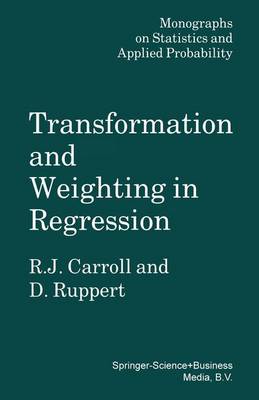Chapman & Hall/CRC Monographs on Statistics and Applied Probability
1 primary work • 3 total works
Book 30
Transformation and Weighting in Regression
by Raymond J Carroll and David Ruppert
This monograph provides a careful review of the major statistical techniques used to analyze regression data with nonconstant variability and skewness. The authors have developed statistical techniques--such as formal fitting methods and less formal graphical techniques-- that can be applied to many problems across a range of disciplines, including pharmacokinetics, econometrics, biochemical assays, and fisheries research.
While the main focus of the book in on data transformation and weighting, it also draws upon ideas from diverse fields such as influence diagnostics, robustness, bootstrapping, nonparametric data smoothing, quasi-likelihood methods, errors-in-variables, and random coefficients. The authors discuss the computation of estimates and give numerous examples using real data. The book also includes an extensive treatment of estimating variance functions in regression.
Measurement Error in Nonlinear Models
by Raymond J Carroll, David Ruppert, Leonard A Stefanski, and Ciprian M Crainiceanu
Functional Data Analysis with R
by Ciprian M Crainiceanu, Jeff Goldsmith, Andrew Leroux, and Erjia Cui
Emerging technologies generate data sets of increased size and complexity that require new or updated statistical inferential methods and scalable, reproducible software. These data sets often involve measurements of a continuous underlying process, and benefit from a functional data perspective. Functional Data Analysis with R presents many ideas for handling functional data including dimension reduction techniques, smoothing, functional regression, structured decompositions of curves, and clustering. The idea is for the reader to be able to immediately reproduce the results in the book, implement these methods, and potentially design new methods and software that may be inspired by these approaches.
Features:
- Functional regression models receive a modern treatment that allows extensions to many practical scenarios and development of state-of-the-art software.
- The connection between functional regression, penalized smoothing, and mixed effects models is used as the cornerstone for inference.
- Multilevel, longitudinal, and structured functional data are discussed with emphasis on emerging functional data structures.
- Methods for clustering functional data before and after smoothing are discussed.
- Multiple new functional data sets with dense and sparse sampling designs from various application areas are presented, including the NHANES linked accelerometry and mortality data, COVID-19 mortality data, CD4 counts data, and the CONTENT child growth study.
- Step-by-step software implementations are included, along with a supplementary website (www.FunctionalDataAnalysis.com) featuring software, data, and tutorials.
- More than 100 plots for visualization of functional data are presented.
Functional Data Analysis with R is primarily aimed at undergraduate, master's, and PhD students, as well as data scientists and researchers working on functional data analysis. The book can be read at different levels and combines state-of-the-art software, methods, and inference. It can be used for self-learning, teaching, and research, and will particularly appeal to anyone who is interested in practical methods for hands-on, problem-forward functional data analysis. The reader should have some basic coding experience, but expertise in R is not required.

